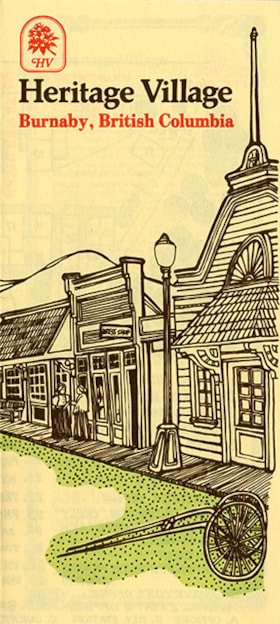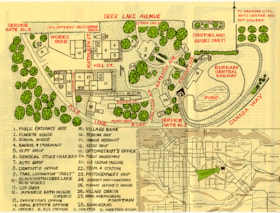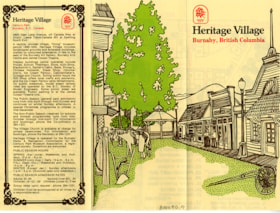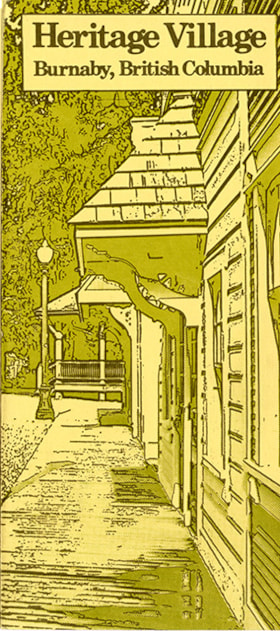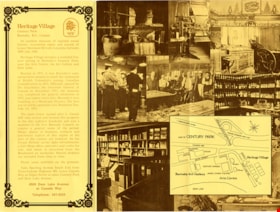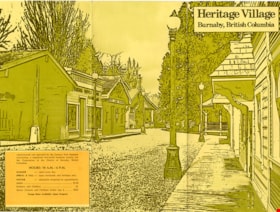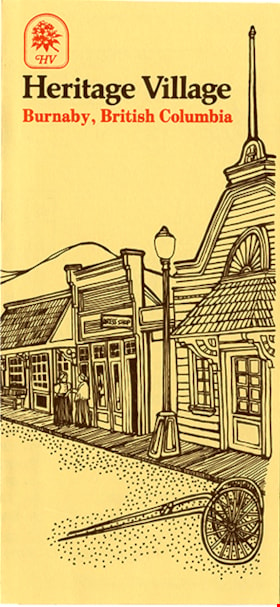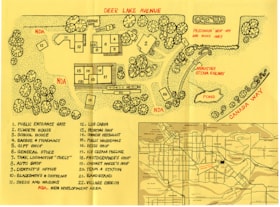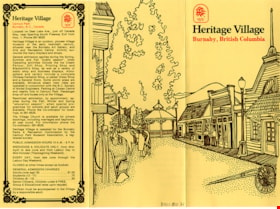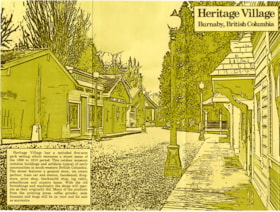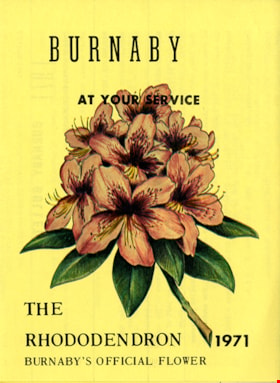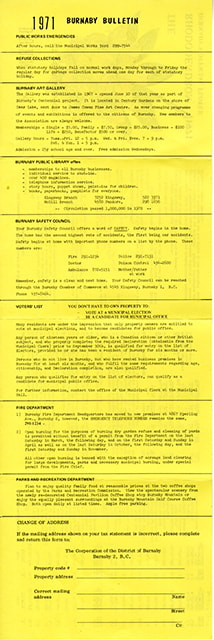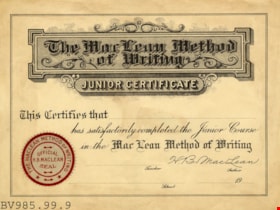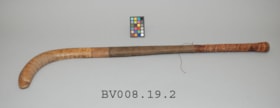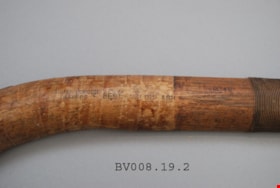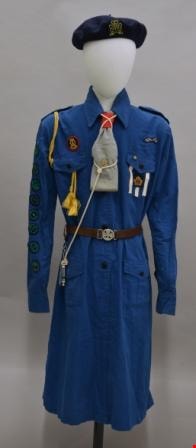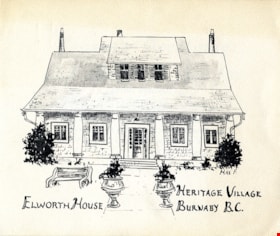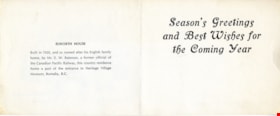Narrow Results By
Subject
- Adornment - Lapel Pins 1
- Advertising Medium 2
- Advertising Medium - Flyer 1
- Advertising Medium - Poster 1
- Advertising Medium - Signs and Signboards 1
- Building Components 1
- Buildings - Judicial - Courthouses 1
- Celebrations 3
- Celebrations - Centennial 1
- Celebrations - Centennials 9
- Ceremonial Artifacts 2
- Ceremonies 1
Person / Organization
- Air Raid Precautions (A.R.P.) 1
- Bingham, Alfred "Alf" 1
- Bossort, Kathy 9
- Bradbury, Dr. Bettina 5
- British Columbia Electric Railway Company 1
- Brown, Charles B. "Charlie" 3
- Brown, Donald N. "Don" 1
- Burnaby Centennial '71 Committee 8
- Burnaby - Centennial Way 1
- Burnaby Citizens Association 1
- Burnaby Mountain Centennial Park 2
- Burnaby Mountain Conservation Area 4
brochure
https://search.heritageburnaby.ca/link/museumartifact84658
- Repository
- Burnaby Village Museum
- Accession Code
- BV011.50.19
- Description
- Heritage Village Museum brochure; trifold; yellow paper with brown, green and red print and illustrations; title on cover reads "Heritage Village / Burnaby, British Columbia" with illustration of buildings on Hill Street inside Heritage Village; interior of brochure includes a site map of Heritage Village; inside fold of brochure provides history of Heritage Village as well as hours of operation, contact information and admision rates.
- Object History
- Heritage Village Museum was officially opened in November 1971 as Burnaby's commemorative project to mark the centennial of British Columbia joining Canadian Confederation in 1871. Heritage Village (Burnaby Village Museum) was governed by the Century Park Museum Association which formed in October 1971. The association continued to govern the village museum until the end of 1989. In 1990, the Corporation of the District of Burnaby assumed the operation and management of Burnaby Village Museum and the Burnaby Village Museum Association was dissolved.
- Category
- 08. Communication Artifacts
- Classification
- Documentary Artifacts - - Other Documents
- Object Term
- Brochure
- Measurements
- Width: 9.5 cm
- Length: 21 cm
- Country Made
- Canada
- Province Made
- British Columbia
- Title
- Heritage Village
- Publication Date
- [1977]
- Subjects
- Documentary Artifacts - Pamphlets
Images
brochure
https://search.heritageburnaby.ca/link/museumartifact84659
- Repository
- Burnaby Village Museum
- Accession Code
- BV011.50.20
- Description
- Heritage Village Museum brochure; trifold; yellow paper with green and brown ink on cover; title on cover reads "Heritage Village / Burnaby, British Columbia" with screened photographic image of buildings on the Hill Street inside Heritage Village; interior of brochure includes background information about Heritage Village, a photograph montage of images with an inset map identifying the location of Heritage Village; orange rectangular piece of paper attached over top of outdated information on inside fold of brochure includes hours of operation and admission rates,
- Object History
- Heritage Village Museum was officially opened in November 1971 as Burnaby's commemorative project to mark the centennial of British Columbia joining Canadian Confederation in 1871. Heritage Village (Burnaby Village Museum) was governed by the Century Park Museum Association which formed in October 1971. The association continued to govern the village museum until the end of 1989. In 1990, the Corporation of the District of Burnaby assumed the operation and management of Burnaby Village Museum and the Burnaby Village Museum Association was dissolved.
- Category
- 08. Communication Artifacts
- Classification
- Documentary Artifacts - - Other Documents
- Object Term
- Brochure
- Measurements
- Width: 10 cm
- Length: 22 cm
- Country Made
- Canada
- Province Made
- British Columbia
- Site/City Made
- Burnaby
- Title
- Heritage Village
- Publication Date
- [197-]
- Subjects
- Documentary Artifacts - Pamphlets
Images
brochure
https://search.heritageburnaby.ca/link/museumartifact84660
- Repository
- Burnaby Village Museum
- Accession Code
- BV011.50.21
- Description
- Heritage Village Museum brochure; trifold; yellow paper with brown, green and red print and illustrations; tilte on cover reads "Heritage Village / Burnaby, British Columbia" with illustration of buildings on Hill Street inside Heritage Village; interior of brochure includes a site map of Heritage Village; inside fold of brochure provides history of Heritage Village as well as hours of operation, contact information and admission rates.
- Object History
- Heritage Village Museum was officially opened in November 1971 as Burnaby's commemorative project to mark the centennial of British Columbia joining Canadian Confederation in 1871. Heritage Village (Burnaby Village Museum) was governed by the Century Park Museum Association which formed in October 1971. The association continued to govern the village museum until the end of 1989. In 1990, the Corporation of the District of Burnaby assumed the operation and management of Burnaby Village Museum and the Burnaby Village Museum Association was dissolved.
- Category
- 08. Communication Artifacts
- Classification
- Documentary Artifacts - - Other Documents
- Object Term
- Brochure
- Measurements
- Width: 10 cm
- Length: 22 cm
- Publication Date
- [1975]
- Subjects
- Documentary Artifacts - Pamphlets
Images
brochure
https://search.heritageburnaby.ca/link/museumartifact91116
- Repository
- Burnaby Village Museum
- Accession Code
- BV020.5.2000
- Description
- Heritage Village brochure; trifold; yellow paper with green and brown ink on cover; title on cover reads "Heritage Village / Burnaby, British Columbia" with screened photographic image of buildings on the Hill Street inside Heritage Village; interior of Brochure includes information with headings "Enter / Heritage Village"; "Spend an Afternoon" with list of what's available; location information and a photograph montage of images with an inset Map identifying the location of Heritage Village in Burnaby; inset text box in lower left corner of cover image includes background information about Heritage Village.
- Object History
- Heritage Village Museum was officially opened in November 1971 as Burnaby's commemorative project to mark the centennial of British Columbia joining Canadian Confederation in 1871. Heritage Village (Burnaby Village Museum) was governed by the Century Park Museum Association which formed in October 1971. The association continued to govern the village museum until the end of 1989. In 1990, the Corporation of the District of Burnaby assumed the operation and management of Burnaby Village Museum and the Burnaby Village Museum Association was dissolved.
- Category
- 08. Communication Artifacts
- Classification
- Documentary Artifacts - - Other Documents
- Object Term
- Brochure
- Measurements
- 22 cm x 29 cm folded to 22 cm x 9.6 cm
- Country Made
- Canada
- Province Made
- British Columbia
- Site/City Made
- Burnaby
- Title
- Heritage Village
- Publication Date
- [197-]
- Subjects
- Documentary Artifacts - Pamphlets
Images
brochure
https://search.heritageburnaby.ca/link/museumartifact91372
- Repository
- Burnaby Village Museum
- Accession Code
- BV020.5.2119
- Description
- Corporation of the District of Burnaby brochure; foldout; yellow paper with black print; cover illustration of pink rhododendron. Text on front cover reads: "BURNABY AT YOUR SERVICE / THE RHODODENDRON 1971 / BURNABY'S OFFICIAL FLOWER". Three sections of same side of brochure have information from "THE CORPORATION OF THE DISTRICT OF BURNABY / BURNABY B.C." including tax payments, other municipal charges, assessments, home owner grant, school board and municipal budget; other side of paper reads vertically and has title reading: "1971 BURNABY BULLETIN" and includes information on public works emergencies, refuse collection,Burnaby Art Gallery, Burnaby Public Library, Burnaby Safety Council, Voters' List, Fire Department, Parks and Recreation Department and includes a change of address form at bottom.
- Object History
- Brochure created by the Corporation of the District of Burnaby and distributed to Burnaby citizens.
- Category
- 08. Communication Artifacts
- Classification
- Documentary Artifacts - - Other Documents
- Object Term
- Brochure
- Marks/Labels
- invitation has marks from being handled
- Colour
- Yellow
- Black
- Green
- Pink
- Measurements
- Length: 13.5 cm
- Width: 40 cm
- Folded to: Length: 13.5 cm x Width: 10 cm
- Country Made
- Canada
- Province Made
- British Columbia
- Site/City Made
- Burnaby
- Publication Date
- 1971
Images
Burnaby Village Museum fonds
https://search.heritageburnaby.ca/link/museumdescription13037
- Repository
- Burnaby Village Museum
- Date
- 1990-2019
- Collection/Fonds
- Burnaby Village Museum fonds
- Description Level
- Fonds
- Physical Description
- Over 3000 photographs + approx. 100 architectural drawings + technical drawings + 25 videocassettes + 43 video recordings (mp4) + 2 video recordings (m4v) + 56 sound recordings (mp3) + 5 audio cassettes + approx. 2 m. of textual records
- Scope and Content
- Fonds consists of a selection of curatorial records created and collected by the Burnaby Village Museum in the course of their work. Records pertain to the village site, exhibits, programs, curatorial projects, outreach and special events. Fonds is arranged in the following series: 1) Museum photo…
- Repository
- Burnaby Village Museum
- Collection/Fonds
- Burnaby Village Museum fonds
- Description Level
- Fonds
- Physical Description
- Over 3000 photographs + approx. 100 architectural drawings + technical drawings + 25 videocassettes + 43 video recordings (mp4) + 2 video recordings (m4v) + 56 sound recordings (mp3) + 5 audio cassettes + approx. 2 m. of textual records
- Scope and Content
- Fonds consists of a selection of curatorial records created and collected by the Burnaby Village Museum in the course of their work. Records pertain to the village site, exhibits, programs, curatorial projects, outreach and special events. Fonds is arranged in the following series: 1) Museum photographs series 2) Museum film collection series 3) Museum architectural records series 4) Museum Marketing photographs series 5) Museum exhibits series 6) Museum reports series 7) Curatorial Collections adminstrative records series 8) Museum Oral Histories series 9) Jesse Love farmhouse series 10) Bell's Dry Goods series 11) Burnaby Neighbourhood Speaker Series series 12) C.W. Parker no. 119 carousel series 13) Royal Bank exhibit series 14) UBC Partnership series 15) Burnaby Community Heritage Commission 125 Video Collection series
- History
- Burnaby Village Museum is an open air museum that represents a typical tram-stop community. Museum interpreters welcome visitors, provide demonstrations and on site programming. The museum’s collection consists of thousands of artifacts, community records as well as several original Burnaby heritage buildings, a 1912 carousel, 1912 B.C. Electric Railway interurban tram, a Chinese Market Garden and Indigenous Learning House and Matriarch's Garden. In 1990, the Corporation of the District of Burnaby assumed the operation and management of Burnaby Village Museum from the Burnaby Village Museum Association. Burnaby Village Museum (formerly named Heritage Village) was originally created by the Burnaby Centennial '71 Committee in 1971 as a commemorative project for British Columbia's Centennial. A concept for an open-air museum was developed near Deer Lake on Districts Lots 79/ 85. The official sod turning for Heritage Village took place on the site on April 11, 1971. In the spring of 1971, a museum director and curator were hired to oversee the development of the project and the acquisition of artifacts with funding from the Parks and Recreation Commission. The Century Park Museum Association (later named Burnaby Village Museum Association) was formed on October 26, 1971 as a governing body for Heritage Village Museum. The museum opened on November 19, 1971 with Mayor Bob Pritte and Canada's Governor General Roland Michener. IN July 1972, the museum opened for it's first public season. The Village was described as depictive of the 1890 to 1920 era of the lower mainland. Since 1990, the site expanded from it’s original four acre size to it's current ten acres. In the 1990s and early 2000s staff and volunteers created exhibits and programs about Burnaby with an emphasis on the 1920s. Since it's 40th anniversary in 2011, the museum has implemented changes to make the museum more interactive and inclusive in telling the story of Burnaby's history.
- Creator
- Burnaby Village Museum
- Accession Code
- X2294
- X5124
- X5125
- BV013.19
- BV017.39
- BV017.45
- BV018.6
- BV018.12
- BV018.14
- BV018.18
- BV018.41
- BV019.2
- BV019.13
- BV019.15
- BV019.18
- BV019.19
- BV019.36
- Bv019.39
- BV019.52
- BV019.61
- BV020.4
- BV020.5
- BV020.12
- BV020.28
- BV020.29
- BV021.5
- BV021.7
- BV021.14
- BV021.17
- BV021.31
- BV022.1
- BV022.2
- BV022.27
- Date
- 1990-2019
- Media Type
- Architectural Drawing
- Moving Images
- Photograph
- Sound Recording
- Technical Drawing
- Textual Record
- Arrangement
- The following series have been arranged into subseries: Exhibits series; Oral History series; Jesse Love farmhouse series; Bell's Dry Goods exhibits series; Burnaby Neighbourhood Speaker Series series; C.W. Parker no. 119 carousel series; Royal Bank exhibits series; UBC Partnership series
- Notes
- Title based on contents of fonds
- Further accruals expected
- For other records pertaining to the history of Burnaby Village Museum see: Don Copan collection; Burnaby Centennial '71 Committee collection; Century Park Museum Association fonds; Don Wrigley fonds
- See Artifacts descriptions for Publications and Newsletters produced by Burnaby Village Museum and Century Park Museum Association
certificate
https://search.heritageburnaby.ca/link/museumartifact6663
- Repository
- Burnaby Village Museum
- Accession Code
- BV985.99.8
- Description
- The MacLean Method of Writing - Certificate -- [19--?]. Blank certificate for the Junior course for the MacLean Method of Writing. The ceritifcate has the Official H.B. MacLean Seasl in red embossed on the bottom left corner. The certificate has blank spots for the student's name, teacher's name, and name of the school.
Images
commemorative certificate
https://search.heritageburnaby.ca/link/museumartifact91046
- Repository
- Burnaby Village Museum
- Accession Code
- BV020.5.1771
- Description
- Commemorative certificate; orange textured cardstock with black ink; decorative clipart borders with text between that reads: "Burnaby Village Museum / This is to certify that / ______________ / attended the official re-opening of the 1922 / Seaforth School / on / April 10, 1987"
- Object History
- Item was found in Burnaby Village Museum printshop along with other Heritage Village / Burnaby Village Museum ephemera created between 1971 and 1990
- Category
- 08. Communication Artifacts
- Classification
- Documentary Artifacts - - Memorabilia
- Object Term
- Certificate
- Measurements
- 21.5 x 14 cm
- Country Made
- Canada
- Province Made
- British Columbia
- Subjects
- Documentary Artifacts
- Names
- Burnaby Village Museum
Images
field hockey stick
https://search.heritageburnaby.ca/link/museumartifact80102
- Repository
- Burnaby Village Museum
- Accession Code
- BV008.19.2
- Description
- The field hockey stick is made of ash. It has a fairly flat curve on the blade. It is round at the handle and gradually flattens and curves towards the blade of the stick. The blade is flat on one side and rounded at the back. The handle is leather wrapped for 27 cm. and then it is string wrapped for 31 cm. Overall length is 90 cm. The end of the handle is 4 cm diameter "JAQUES LONDON / MAKERS", printed on back of blade "BEST ENGLISH ASH" printed on back of blade "M Thomson" written in ink on back of blade. "20 oz" stamped in back edge of blade just below string wrapping. "THIS STICK / IS GUARENTEED / TO HAVE PASSED / THE OFFICIAL TEST / OF THE / HOCKEY _______IATION" printed in a circle on the face of the blade below the string wrapping "Special" printed in script on theblade face just below the string wrapping "The Bul_er / BULGER / ________" printed on the face of the blade
- Object History
- Used by the Thomson family in the Kerrisdale area of Vancouver. M. Thomson's name is on the stick
- Subjects
- Sports
- Sports - Gymnastics
- Sports Equipment
Images
hat
https://search.heritageburnaby.ca/link/museumartifact87414
- Repository
- Burnaby Village Museum
- Accession Code
- BV015.36.63
- Description
- uniform hat, Girl Guides; soft, navy wool beret; square yellow Girl Guides Canada badge stitched on front; "GIRL GUIDES / OF / CANADA / OFFICIAL BERET / 100% VIRGIN WOOL / MADE IN CANADA / PARKURST KNITWEAR / MOTHPROOFED - WATER REPELLENT / MEDIUM".
- Object History
- Salvation Army Guide uniform dress belonging to Virginia Blake, early 1960s. From the 6th Vancouver Salvation Army Guides on Hastings Street. Salvation Army was affiliated with Girl Guides (1937) of Canada until 1998. Worn with brown leather belt, beret, folded triangular company tie. The three white stripes on the right breast pocket indicate that wearer was a company leader. The more stripes you had, the higher your rank. A single white stripe, sewn down the center of the pocket, would have indicated that she was a patrol seconder. Two stripes would indicate that she was a patrol leader. White adhesive tape was used so that the guider didn’t have to unstitch and re-sew the stripes as they gained rank.
- Category
- 03. Personal Artifacts
- Classification
- Clothing
- Clothing - - Headwear
- Names
- Girl Guides of Canada
Images
holiday card
https://search.heritageburnaby.ca/link/museumartifact91060
- Repository
- Burnaby Village Museum
- Accession Code
- BV020.5.1785
- Description
- Holiday card; black ink on white paper folded; illustration on front in black ink signed "MAX F." of Elworth house, text at bottom reads "ELWORTH HOUSE_ HERITAGE VILLAGE / BURNABY B.C."/ text inside on verso of front reads: "ELWORTH HOUSE / Buit in 1920, and so named after his English family / home, by Mr. E.W. Bateman, a former official of / the Canadian Pacific Railway, this country residence / forms a part of the entrance to Heritage Village / Museum, Burnaby, B.C."; text message inside facing reads: "Season's Greetings / and Best Wishes for / the Coming Year"; text on back of card reads: "printed at Heritage Village, Burnaby, B.C."
- Object History
- Item was found in Burnaby Village Museum printshop along with other Heritage Village / Burnaby Village Museum ephemera created between 1971 and 1990.
- Category
- 08. Communication Artifacts
- Classification
- Documentary Artifacts - - Other Documents
- Object Term
- Correspondence
- Measurements
- 11.5 x 11.5 cm folded to 5.7 x 10.5 cm
- Country Made
- Canada
- Province Made
- British Columbia
- Subjects
- Documentary Artifacts
- Names
- Burnaby Village Museum
Images
Interview with Barry Jones by Kathy Bossort December 9, 2015 - Track 1
https://search.heritageburnaby.ca/link/oralhistory664
- Repository
- City of Burnaby Archives
- Date Range
- 1944-1970
- Length
- 0:07:55
- Summary
- This portion of the interview is about Barry Jones’ talking about his parent's move to Burnaby in 1944, growing up on Georgia Street, his education at UBC and how he became a teacher. He also talks about his experience attending SFU in 1965/66 as a charter student in the Education Dept.
- Repository
- City of Burnaby Archives
- Summary
- This portion of the interview is about Barry Jones’ talking about his parent's move to Burnaby in 1944, growing up on Georgia Street, his education at UBC and how he became a teacher. He also talks about his experience attending SFU in 1965/66 as a charter student in the Education Dept.
- Date Range
- 1944-1970
- Length
- 0:07:55
- Subjects
- Education
- Occupations - Teachers
- Interviewer
- Bossort, Kathy
- Interview Date
- December 9, 2015
- Scope and Content
- Recording is of an interview with Barry Jones conducted by Kathy Bossort. Barry Jones was one of 23 participants interviewed as part of the Community Heritage Commission’s Burnaby Mountain Oral History Project. The interview is mainly about Barry Jones talking about his home and the conservation area on Burnaby Mountain, and about the negotiations that resulted in the agreement between Simon Fraser University and the City of Burnaby in 1995. He talks about the building of Burnaby Mountain Parkway and its link to the 1995 agreement, and about his experiences with Trans Mountain tank farm and pipeline. He also talks about his education and career as teacher, school board trustee and politician.
- Biographical Notes
- Barry Jones was born 1940 in Princeton, BC. His father moved the family to a home on Georgia Street in North Burnaby in 1944 where Barry grew up. He attended UBC majoring in mathematics and chemistry, and unable to find work in his field, taught two years in northern BC. He liked teaching and returned to school, enrolling in education at the newly opened Simon Fraser University in 1965. He taught one year at Moscrop Secondary School in Burnaby and finished his 25 year teaching career in Coquitlam. Barry served ten years as a Burnaby School board trustee, and then ten years as North Burnaby MLA (NDP) beginning in 1986, serving five years in Official Opposition and five years in government under then-premier Mike Harcourt. During his time in government, Barry Jones successfully lobbied for freedom of information legislation. He also played a role in resolving the dispute between SFU and Burnaby over control and ownership of land on Burnaby Mountain and in creating the Burnaby Mountain Conservation Area in 1995. He continues to live on Burnaby Mountain in a home he bought in 1971.
- Total Tracks
- 7
- Total Length
- 1:06:23
- Interviewee Name
- Jones, J. Barry
- Interview Location
- City of Burnaby City Hall law libary
- Interviewer Bio
- Kathy Bossort is a retired archivist living in Ladner, BC. She worked at the Delta Museum and Archives after graduating from SLAIS (UBC) in 2001 with Masters degrees in library science and archival studies. Kathy grew up in Calgary, Alberta, and, prior to this career change, she lived in the West Kootenays, earning her living as a cook for BC tourist lodges and work camps. She continues to be interested in oral histories as a way to fill the gaps in the written record and bring richer meaning to history.
- Collection/Fonds
- Community Heritage Commission Special Projects fonds
- Media Type
- Sound Recording
Audio Tracks
Track one of interview with Barry Jones
Track one of interview with Barry Jones
https://search.heritageburnaby.ca/media/hpo/_Data/_Archives_Oral_Histories/_Unrestricted/MSS196-015/MSS196-015_Track_1.mp3Interview with Barry Jones by Kathy Bossort December 9, 2015 - Track 2
https://search.heritageburnaby.ca/link/oralhistory665
- Repository
- City of Burnaby Archives
- Date Range
- 1970-2015
- Length
- 0:08:17
- Summary
- This portion of the interview is about Barry Jones’ talking about buying his Centennial Way home on Burnaby Mountain in 1971, the 1972 proposal for developing the south slope of the mountain, and the 1974 public hearings that resulted in the designation of the conservation area on Burnaby Mountain.…
- Repository
- City of Burnaby Archives
- Summary
- This portion of the interview is about Barry Jones’ talking about buying his Centennial Way home on Burnaby Mountain in 1971, the 1972 proposal for developing the south slope of the mountain, and the 1974 public hearings that resulted in the designation of the conservation area on Burnaby Mountain. He also talks about what the conservation area means to him and how the area has changed little since 1971.
- Date Range
- 1970-2015
- Length
- 0:08:17
- Subjects
- Geographic Features - Parks
- Geographic Access
- Burnaby Mountain Conservation Area
- Interviewer
- Bossort, Kathy
- Interview Date
- December 9, 2015
- Scope and Content
- Recording is of an interview with Barry Jones conducted by Kathy Bossort. Barry Jones was one of 23 participants interviewed as part of the Community Heritage Commission’s Burnaby Mountain Oral History Project. The interview is mainly about Barry Jones talking about his home and the conservation area on Burnaby Mountain, and about the negotiations that resulted in the agreement between Simon Fraser University and the City of Burnaby in 1995. He talks about the building of Burnaby Mountain Parkway and its link to the 1995 agreement, and about his experiences with Trans Mountain tank farm and pipeline. He also talks about his education and career as teacher, school board trustee and politician.
- Biographical Notes
- Barry Jones was born 1940 in Princeton, BC. His father moved the family to a home on Georgia Street in North Burnaby in 1944 where Barry grew up. He attended UBC majoring in mathematics and chemistry, and unable to find work in his field, taught two years in northern BC. He liked teaching and returned to school, enrolling in education at the newly opened Simon Fraser University in 1965. He taught one year at Moscrop Secondary School in Burnaby and finished his 25 year teaching career in Coquitlam. Barry served ten years as a Burnaby School board trustee, and then ten years as North Burnaby MLA (NDP) beginning in 1986, serving five years in Official Opposition and five years in government under then-premier Mike Harcourt. During his time in government, Barry Jones successfully lobbied for freedom of information legislation. He also played a role in resolving the dispute between SFU and Burnaby over control and ownership of land on Burnaby Mountain and in creating the Burnaby Mountain Conservation Area in 1995. He continues to live on Burnaby Mountain in a home he bought in 1971.
- Total Tracks
- 7
- Total Length
- 1:06:23
- Interviewee Name
- Jones, J. Barry
- Interview Location
- City of Burnaby City Hall law libary
- Interviewer Bio
- Kathy Bossort is a retired archivist living in Ladner, BC. She worked at the Delta Museum and Archives after graduating from SLAIS (UBC) in 2001 with Masters degrees in library science and archival studies. Kathy grew up in Calgary, Alberta, and, prior to this career change, she lived in the West Kootenays, earning her living as a cook for BC tourist lodges and work camps. She continues to be interested in oral histories as a way to fill the gaps in the written record and bring richer meaning to history.
- Collection/Fonds
- Community Heritage Commission Special Projects fonds
- Media Type
- Sound Recording
Audio Tracks
Track two of interview with Barry Jones
Track two of interview with Barry Jones
https://search.heritageburnaby.ca/media/hpo/_Data/_Archives_Oral_Histories/_Unrestricted/MSS196-015/MSS196-015_Track_2.mp3Interview with Barry Jones by Kathy Bossort December 9, 2015 - Track 3
https://search.heritageburnaby.ca/link/oralhistory666
- Repository
- City of Burnaby Archives
- Date Range
- 1967-2015
- Length
- 0:09:36
- Summary
- This portion of the interview is about Barry Jones’ talking about the rhododendron garden planted in 1967 on Centennial Way for Canada’s Centennial and the gardens current neglect. He talks about management of the conservation area and the Pavilion area, the trails on the mountain, and the people w…
- Repository
- City of Burnaby Archives
- Summary
- This portion of the interview is about Barry Jones’ talking about the rhododendron garden planted in 1967 on Centennial Way for Canada’s Centennial and the gardens current neglect. He talks about management of the conservation area and the Pavilion area, the trails on the mountain, and the people who use the trails.
- Date Range
- 1967-2015
- Length
- 0:09:36
- Geographic Access
- Burnaby Mountain Conservation Area
- Interviewer
- Bossort, Kathy
- Interview Date
- December 9, 2015
- Scope and Content
- Recording is of an interview with Barry Jones conducted by Kathy Bossort. Barry Jones was one of 23 participants interviewed as part of the Community Heritage Commission’s Burnaby Mountain Oral History Project. The interview is mainly about Barry Jones talking about his home and the conservation area on Burnaby Mountain, and about the negotiations that resulted in the agreement between Simon Fraser University and the City of Burnaby in 1995. He talks about the building of Burnaby Mountain Parkway and its link to the 1995 agreement, and about his experiences with Trans Mountain tank farm and pipeline. He also talks about his education and career as teacher, school board trustee and politician.
- Biographical Notes
- Barry Jones was born 1940 in Princeton, BC. His father moved the family to a home on Georgia Street in North Burnaby in 1944 where Barry grew up. He attended UBC majoring in mathematics and chemistry, and unable to find work in his field, taught two years in northern BC. He liked teaching and returned to school, enrolling in education at the newly opened Simon Fraser University in 1965. He taught one year at Moscrop Secondary School in Burnaby and finished his 25 year teaching career in Coquitlam. Barry served ten years as a Burnaby School board trustee, and then ten years as North Burnaby MLA (NDP) beginning in 1986, serving five years in Official Opposition and five years in government under then-premier Mike Harcourt. During his time in government, Barry Jones successfully lobbied for freedom of information legislation. He also played a role in resolving the dispute between SFU and Burnaby over control and ownership of land on Burnaby Mountain and in creating the Burnaby Mountain Conservation Area in 1995. He continues to live on Burnaby Mountain in a home he bought in 1971.
- Total Tracks
- 7
- Total Length
- 1:06:23
- Interviewee Name
- Jones, J. Barry
- Interview Location
- City of Burnaby City Hall law libary
- Interviewer Bio
- Kathy Bossort is a retired archivist living in Ladner, BC. She worked at the Delta Museum and Archives after graduating from SLAIS (UBC) in 2001 with Masters degrees in library science and archival studies. Kathy grew up in Calgary, Alberta, and, prior to this career change, she lived in the West Kootenays, earning her living as a cook for BC tourist lodges and work camps. She continues to be interested in oral histories as a way to fill the gaps in the written record and bring richer meaning to history.
- Collection/Fonds
- Community Heritage Commission Special Projects fonds
- Media Type
- Sound Recording
Audio Tracks
Track three of interview with Barry Jones
Track three of interview with Barry Jones
https://search.heritageburnaby.ca/media/hpo/_Data/_Archives_Oral_Histories/_Unrestricted/MSS196-015/MSS196-015_Track_3.mp3Interview with Barry Jones by Kathy Bossort December 9, 2015 - Track 4
https://search.heritageburnaby.ca/link/oralhistory667
- Repository
- City of Burnaby Archives
- Date Range
- 1975-1996
- Length
- 0:11:00
- Summary
- This portion of the interview is about Barry Jones’ talking briefly about serving as a trustee on the Burnaby Board of Education from 1975 to 1985 and as NDP MLA from 1986 to 1996, before describing his limited role in the dispute between the City of Burnaby and SFU over control and ownership of la…
- Repository
- City of Burnaby Archives
- Summary
- This portion of the interview is about Barry Jones’ talking briefly about serving as a trustee on the Burnaby Board of Education from 1975 to 1985 and as NDP MLA from 1986 to 1996, before describing his limited role in the dispute between the City of Burnaby and SFU over control and ownership of land on Burnaby Mountain. He talks about how the dispute was resolved and some of the terms in the agreement.
- Date Range
- 1975-1996
- Length
- 0:11:00
- Names
- Burnaby School Board
- Simon Fraser University
- Rankin, Lee A.
- Burnaby Mountain Conservation Area
- Geographic Access
- Burnaby Mountain Conservation Area
- Interviewer
- Bossort, Kathy
- Interview Date
- December 9, 2015
- Scope and Content
- Recording is of an interview with Barry Jones conducted by Kathy Bossort. Barry Jones was one of 23 participants interviewed as part of the Community Heritage Commission’s Burnaby Mountain Oral History Project. The interview is mainly about Barry Jones talking about his home and the conservation area on Burnaby Mountain, and about the negotiations that resulted in the agreement between Simon Fraser University and the City of Burnaby in 1995. He talks about the building of Burnaby Mountain Parkway and its link to the 1995 agreement, and about his experiences with Trans Mountain tank farm and pipeline. He also talks about his education and career as teacher, school board trustee and politician.
- Biographical Notes
- Barry Jones was born 1940 in Princeton, BC. His father moved the family to a home on Georgia Street in North Burnaby in 1944 where Barry grew up. He attended UBC majoring in mathematics and chemistry, and unable to find work in his field, taught two years in northern BC. He liked teaching and returned to school, enrolling in education at the newly opened Simon Fraser University in 1965. He taught one year at Moscrop Secondary School in Burnaby and finished his 25 year teaching career in Coquitlam. Barry served ten years as a Burnaby School board trustee, and then ten years as North Burnaby MLA (NDP) beginning in 1986, serving five years in Official Opposition and five years in government under then-premier Mike Harcourt. During his time in government, Barry Jones successfully lobbied for freedom of information legislation. He also played a role in resolving the dispute between SFU and Burnaby over control and ownership of land on Burnaby Mountain and in creating the Burnaby Mountain Conservation Area in 1995. He continues to live on Burnaby Mountain in a home he bought in 1971.
- Total Tracks
- 7
- Total Length
- 1:06:23
- Interviewee Name
- Jones, J. Barry
- Interview Location
- City of Burnaby City Hall law libary
- Interviewer Bio
- Kathy Bossort is a retired archivist living in Ladner, BC. She worked at the Delta Museum and Archives after graduating from SLAIS (UBC) in 2001 with Masters degrees in library science and archival studies. Kathy grew up in Calgary, Alberta, and, prior to this career change, she lived in the West Kootenays, earning her living as a cook for BC tourist lodges and work camps. She continues to be interested in oral histories as a way to fill the gaps in the written record and bring richer meaning to history.
- Collection/Fonds
- Community Heritage Commission Special Projects fonds
- Media Type
- Sound Recording
Audio Tracks
Track four of interview with Barry Jones
Track four of interview with Barry Jones
https://search.heritageburnaby.ca/media/hpo/_Data/_Archives_Oral_Histories/_Unrestricted/MSS196-015/MSS196-015_Track_4.mp3Interview with Barry Jones by Kathy Bossort December 9, 2015 - Track 5
https://search.heritageburnaby.ca/link/oralhistory668
- Repository
- City of Burnaby Archives
- Date Range
- 1980-2015
- Length
- 0:13:13
- Summary
- This portion of the interview is about Barry Jones’ talking about the building of the Burnaby Mountain Parkway, and its link with the SFU/City agreement and development in the Philips/Curtis area. He talks about the Burnaby Mountain Preservation Society and members Karen Morcke and Dean Lamont. He …
- Repository
- City of Burnaby Archives
- Summary
- This portion of the interview is about Barry Jones’ talking about the building of the Burnaby Mountain Parkway, and its link with the SFU/City agreement and development in the Philips/Curtis area. He talks about the Burnaby Mountain Preservation Society and members Karen Morcke and Dean Lamont. He also talks about some of the key people involved in the negotiations between City and SFU, the ceremony at which the agreement was signed, and the plaque in the Pavilion area that commemorates the agreement.
- Date Range
- 1980-2015
- Length
- 0:13:13
- Names
- Simon Fraser University
- Burnaby Mountain Conservation Area
- Burnaby Mountain Parkway
- Burnaby Mountain Preservation Society
- Morcke, Karen
- Geographic Access
- Burnaby Mountain Conservation Area
- Interviewer
- Bossort, Kathy
- Interview Date
- December 9, 2015
- Scope and Content
- Recording is of an interview with Barry Jones conducted by Kathy Bossort. Barry Jones was one of 23 participants interviewed as part of the Community Heritage Commission’s Burnaby Mountain Oral History Project. The interview is mainly about Barry Jones talking about his home and the conservation area on Burnaby Mountain, and about the negotiations that resulted in the agreement between Simon Fraser University and the City of Burnaby in 1995. He talks about the building of Burnaby Mountain Parkway and its link to the 1995 agreement, and about his experiences with Trans Mountain tank farm and pipeline. He also talks about his education and career as teacher, school board trustee and politician.
- Biographical Notes
- Barry Jones was born 1940 in Princeton, BC. His father moved the family to a home on Georgia Street in North Burnaby in 1944 where Barry grew up. He attended UBC majoring in mathematics and chemistry, and unable to find work in his field, taught two years in northern BC. He liked teaching and returned to school, enrolling in education at the newly opened Simon Fraser University in 1965. He taught one year at Moscrop Secondary School in Burnaby and finished his 25 year teaching career in Coquitlam. Barry served ten years as a Burnaby School board trustee, and then ten years as North Burnaby MLA (NDP) beginning in 1986, serving five years in Official Opposition and five years in government under then-premier Mike Harcourt. During his time in government, Barry Jones successfully lobbied for freedom of information legislation. He also played a role in resolving the dispute between SFU and Burnaby over control and ownership of land on Burnaby Mountain and in creating the Burnaby Mountain Conservation Area in 1995. He continues to live on Burnaby Mountain in a home he bought in 1971.
- Total Tracks
- 7
- Total Length
- 1:06:23
- Interviewee Name
- Jones, J. Barry
- Interview Location
- City of Burnaby City Hall law libary
- Interviewer Bio
- Kathy Bossort is a retired archivist living in Ladner, BC. She worked at the Delta Museum and Archives after graduating from SLAIS (UBC) in 2001 with Masters degrees in library science and archival studies. Kathy grew up in Calgary, Alberta, and, prior to this career change, she lived in the West Kootenays, earning her living as a cook for BC tourist lodges and work camps. She continues to be interested in oral histories as a way to fill the gaps in the written record and bring richer meaning to history.
- Collection/Fonds
- Community Heritage Commission Special Projects fonds
- Media Type
- Sound Recording
Audio Tracks
Track five of interview with Barry Jones
Track five of interview with Barry Jones
https://search.heritageburnaby.ca/media/hpo/_Data/_Archives_Oral_Histories/_Unrestricted/MSS196-015/MSS196-015_Track_5.mp3Interview with Barry Jones by Kathy Bossort December 9, 2015 - Track 6
https://search.heritageburnaby.ca/link/oralhistory669
- Repository
- City of Burnaby Archives
- Date Range
- 1985-2015
- Length
- 0:08:16
- Summary
- This portion of the interview is about Barry Jones’ talking about the Trans Mountain tank farm. He also talks about how SFU has benefitted Burnaby and the improved relationship between the the City and the university.
- Repository
- City of Burnaby Archives
- Summary
- This portion of the interview is about Barry Jones’ talking about the Trans Mountain tank farm. He also talks about how SFU has benefitted Burnaby and the improved relationship between the the City and the university.
- Date Range
- 1985-2015
- Length
- 0:08:16
- Subjects
- Industries - Petroleum Industry
- Geographic Access
- Burnaby Mountain Conservation Area
- Interviewer
- Bossort, Kathy
- Interview Date
- December 9, 2015
- Scope and Content
- Recording is of an interview with Barry Jones conducted by Kathy Bossort. Barry Jones was one of 23 participants interviewed as part of the Community Heritage Commission’s Burnaby Mountain Oral History Project. The interview is mainly about Barry Jones talking about his home and the conservation area on Burnaby Mountain, and about the negotiations that resulted in the agreement between Simon Fraser University and the City of Burnaby in 1995. He talks about the building of Burnaby Mountain Parkway and its link to the 1995 agreement, and about his experiences with Trans Mountain tank farm and pipeline. He also talks about his education and career as teacher, school board trustee and politician.
- Biographical Notes
- Barry Jones was born 1940 in Princeton, BC. His father moved the family to a home on Georgia Street in North Burnaby in 1944 where Barry grew up. He attended UBC majoring in mathematics and chemistry, and unable to find work in his field, taught two years in northern BC. He liked teaching and returned to school, enrolling in education at the newly opened Simon Fraser University in 1965. He taught one year at Moscrop Secondary School in Burnaby and finished his 25 year teaching career in Coquitlam. Barry served ten years as a Burnaby School board trustee, and then ten years as North Burnaby MLA (NDP) beginning in 1986, serving five years in Official Opposition and five years in government under then-premier Mike Harcourt. During his time in government, Barry Jones successfully lobbied for freedom of information legislation. He also played a role in resolving the dispute between SFU and Burnaby over control and ownership of land on Burnaby Mountain and in creating the Burnaby Mountain Conservation Area in 1995. He continues to live on Burnaby Mountain in a home he bought in 1971.
- Total Tracks
- 7
- Total Length
- 1:06:23
- Interviewee Name
- Jones, J. Barry
- Interview Location
- City of Burnaby City Hall law libary
- Interviewer Bio
- Kathy Bossort is a retired archivist living in Ladner, BC. She worked at the Delta Museum and Archives after graduating from SLAIS (UBC) in 2001 with Masters degrees in library science and archival studies. Kathy grew up in Calgary, Alberta, and, prior to this career change, she lived in the West Kootenays, earning her living as a cook for BC tourist lodges and work camps. She continues to be interested in oral histories as a way to fill the gaps in the written record and bring richer meaning to history.
- Collection/Fonds
- Community Heritage Commission Special Projects fonds
- Media Type
- Sound Recording
Audio Tracks
Track six of interview with Barry Jones
Track six of interview with Barry Jones
https://search.heritageburnaby.ca/media/hpo/_Data/_Archives_Oral_Histories/_Unrestricted/MSS196-015/MSS196-015_Track_6.mp3Interview with Barry Jones by Kathy Bossort December 9, 2015 - Track 7
https://search.heritageburnaby.ca/link/oralhistory670
- Repository
- City of Burnaby Archives
- Date Range
- 1995-2015
- Length
- 0:08:06
- Summary
- This portion of the interview is about Barry Jones’ talking about UniverCity, the future of the forest on Burnaby Mountain, and the positive uses people make of the parkland. He also talks about the need to improve the entrance to the Pavilion area on the mountain, and suggests that Canada’s 150th …
- Repository
- City of Burnaby Archives
- Summary
- This portion of the interview is about Barry Jones’ talking about UniverCity, the future of the forest on Burnaby Mountain, and the positive uses people make of the parkland. He also talks about the need to improve the entrance to the Pavilion area on the mountain, and suggests that Canada’s 150th Centennial in 2017 would be a good opportunity for doing so.
- Date Range
- 1995-2015
- Length
- 0:08:06
- Subjects
- Geographic Features - Parks
- Geographic Access
- Burnaby Mountain Conservation Area
- Interviewer
- Bossort, Kathy
- Interview Date
- December 9, 2015
- Scope and Content
- Recording is of an interview with Barry Jones conducted by Kathy Bossort. Barry Jones was one of 23 participants interviewed as part of the Community Heritage Commission’s Burnaby Mountain Oral History Project. The interview is mainly about Barry Jones talking about his home and the conservation area on Burnaby Mountain, and about the negotiations that resulted in the agreement between Simon Fraser University and the City of Burnaby in 1995. He talks about the building of Burnaby Mountain Parkway and its link to the 1995 agreement, and about his experiences with Trans Mountain tank farm and pipeline. He also talks about his education and career as teacher, school board trustee and politician.
- Biographical Notes
- Barry Jones was born 1940 in Princeton, BC. His father moved the family to a home on Georgia Street in North Burnaby in 1944 where Barry grew up. He attended UBC majoring in mathematics and chemistry, and unable to find work in his field, taught two years in northern BC. He liked teaching and returned to school, enrolling in education at the newly opened Simon Fraser University in 1965. He taught one year at Moscrop Secondary School in Burnaby and finished his 25 year teaching career in Coquitlam. Barry served ten years as a Burnaby School board trustee, and then ten years as North Burnaby MLA (NDP) beginning in 1986, serving five years in Official Opposition and five years in government under then-premier Mike Harcourt. During his time in government, Barry Jones successfully lobbied for freedom of information legislation. He also played a role in resolving the dispute between SFU and Burnaby over control and ownership of land on Burnaby Mountain and in creating the Burnaby Mountain Conservation Area in 1995. He continues to live on Burnaby Mountain in a home he bought in 1971.
- Total Tracks
- 7
- Total Length
- 1:06:23
- Interviewee Name
- Jones, J. Barry
- Interview Location
- City of Burnaby City Hall law libary
- Interviewer Bio
- Kathy Bossort is a retired archivist living in Ladner, BC. She worked at the Delta Museum and Archives after graduating from SLAIS (UBC) in 2001 with Masters degrees in library science and archival studies. Kathy grew up in Calgary, Alberta, and, prior to this career change, she lived in the West Kootenays, earning her living as a cook for BC tourist lodges and work camps. She continues to be interested in oral histories as a way to fill the gaps in the written record and bring richer meaning to history.
- Collection/Fonds
- Community Heritage Commission Special Projects fonds
- Media Type
- Sound Recording
Audio Tracks
Track seven of interview with Barry Jones
Track seven of interview with Barry Jones
https://search.heritageburnaby.ca/media/hpo/_Data/_Archives_Oral_Histories/_Unrestricted/MSS196-015/MSS196-015_Track_7.mp3Interview with William Pritchard and Norman Penner by Dr. Lawrence Fast July / August 1973 - Track 1
https://search.heritageburnaby.ca/link/oralhistory74
- Repository
- City of Burnaby Archives
- Date Range
- predominate 1919, 1973
- Length
- 0:09:54
- Summary
- This portion of the interview pertains to how the book "Winnipeg 1919", edited by Norman Penner, came into being. Both Norman Penner and labour activist William A. Pritchard answer questions posed by Dr. Lawrence Fast about the Winnipeg General Strike, the subsequent trial and the striker's account…
- Repository
- City of Burnaby Archives
- Summary
- This portion of the interview pertains to how the book "Winnipeg 1919", edited by Norman Penner, came into being. Both Norman Penner and labour activist William A. Pritchard answer questions posed by Dr. Lawrence Fast about the Winnipeg General Strike, the subsequent trial and the striker's account written while in jail.
- Date Range
- predominate 1919, 1973
- Photo Info
- William A. Pritchard, Burnaby Reeve 1930-1932 and council member 1928-1930. Item no. 459-016
- Length
- 0:09:54
- Subjects
- Protests and Demonstrations
- Interviewer
- Fast, Dr. Lawrence
- Interview Date
- July / August 1973
- Scope and Content
- Recording is of an interview with William Pritchard and writer Norman Penner by Dr. Lawrence Fast. Norman Penner is the editor of the book "Winnipeg 1919" about the strike from the striker's perspective. William Pritchard wrote the speech that was included in the book. Major theme discussed is: The Winnipeg General Strike. To view "Narrow By" terms for each track expand this description and see "Notes".
- Biographical Notes
- William "Bill" Arthur Pritchard was born on April 3, 1888 in Salford, England, the son of a miner and factory worker. In May 1911, Bill moved to British Columbia and within a week of arriving became an active member of the Socialist Party of Canada. From 1914 to 1917, he served as editor of the Western Clarion – the SPC newspaper. He became such a well-known socialist figure that when he travelled to Winnipeg to participate in the General Strike in 1919, he was one of only seven people arrested and imprisoned for his participation in the event despite the fact that he was in no way directly involved in its planning nor development. In 1922, Bill and his family settled in North Burnaby in the Capitol Hill District. Almost immediately after his arrival, Bill began to advocate for change and a planned development scheme for the municipality. Pritchard ran successfully for the position of Reeve and held the post until the end of 1932. One of Reeve Pritchard’s highest priorities while in office was to attempt to provide work for as many unemployed as possible all the while trying to elicit more support from the provincial and federal governments. Bill was a strong advocate of the belief that relief work should be focused on projects that would see a comprehensive development scheme for Burnaby – including planned sewers, roads and water supply. Despite Bill's best efforts, however, Burnaby was forced into receivership and at the end of 1932, a Provincial Commission stepped in to take over the governance of the city. Reeve Pritchard, having done all he could as a champion of the unemployed, stepped down as Reeve but left behind an undeniable legacy of courage and determination. He was rewarded for his enormous contributions to the city in 1975 when he was chosen to be made a Freeman of Burnaby. William Pritchard died on October 23, 1981. Norman Penner was born in Winnipeg in 1921 to Rose and Jacob Penner and brother to Roland, Ruth and Walter. Their father Jacob was a leading member of the Communist Party and popular Winnipeg Alderman. Norman graduated from high school in 1937 but did not begin university until much later, preferring to begin his adult life from 1938 to 1941 as a full-time officer of the Winnipeg branch of the Communist Party of Canada. From 1941 to 1946 he served with the Canadian Army which included two-and-a-half years of overseas combat duty. On his return to Canada in 1947 he again returned to his duties as a full-time officer with the communist Labour-Progressive Party (formed in 1941 after the Canadian Communist Party was officially banned). After the abortive Hungarian revolution in 1956, Norman Penner resigned from the party and instead worked as a self-employed manufacturer’s sales representative until 1971. In 1964 he decided to go back to school part time and graduated with a BA from the University of Toronto in 1969. He took an MA in 1971 and a PhD in 1975 from the same institution. Penner was hired as a lecturer at York University's Glendon College in 1972 and soon became a professor, continuing to teach until 1995. He wrote extensively on the Canadian left. Penner edited and introduced "Winnipeg 1919: The Strikers' Own History of the Winnipeg General Strike" in 1973, published "The Canadian Left: A Critical Analysis" in 1977 and contributed three chapters to as well as editing "Keeping Canada Together Means Changing Our Thinking" in 1978. He published "Canadian Communism: The Stalin Years and Beyond" in 1988 and "From Protest to Power: Social Democracy in Canada 1900 to Present" in 1992 as well as numerous articles, reviews and book chapters. Norman Penner was married to Norma Lipes for sixty-seven years. The couple had four children: Steve (Mary Ellen Marus); Joyce (Herman Parsons); Gary (Marlene Kadar); and Bob (Shaena Lambert). Norman Penner died April 16, 2009 at the age of eighty-eight.
- Total Tracks
- 4
- Total Length
- 0:30:47
- Interviewee Name
- Pritchard, William A.
- Penner, Norman
- Fast, Dr. Lawrence
- Interview Location
- Library of Vancouver City College, Langara Campus
- Collection/Fonds
- Burnaby Historical Society fonds
- Subseries
- Oral history subseries
- Media Type
- Sound Recording
- Web Notes
- Interview was digitized in 2010 allowing it to be accessible on Heritage Burnaby. The digitization project was initiated by the Community Heritage Commission with support from City of Burnaby Council and the BC History Digitization Program of the Irving K. Barber Learning Centre, University of British Columbia. It was recognized by the Heritage Society of BC with an award in 2012.
Images
Audio Tracks
Track one of interview with William Pritchard and Norman Penner
Track one of interview with William Pritchard and Norman Penner
https://search.heritageburnaby.ca/media/hpo/_Data/_Archives_Oral_Histories/_Unrestricted/100-13-02-1/100-13-02-1_Track_1.mp3Interview with William Pritchard and Norman Penner by Dr. Lawrence Fast July / August 1973 - Track 2
https://search.heritageburnaby.ca/link/oralhistory75
- Repository
- City of Burnaby Archives
- Date Range
- 1919-1933
- Length
- 0:03:53
- Summary
- This portion of the interview pertains to the impact of the "red scare" at the time of the Winnipeg Strike of 1919. Norman Penner, William Pritchard and Dr. Lawrence Fast discuss this phenomenon.
- Repository
- City of Burnaby Archives
- Summary
- This portion of the interview pertains to the impact of the "red scare" at the time of the Winnipeg Strike of 1919. Norman Penner, William Pritchard and Dr. Lawrence Fast discuss this phenomenon.
- Date Range
- 1919-1933
- Photo Info
- William A. Pritchard, Burnaby Reeve 1930-1932 and council member 1928-1930. Item no. 459-016
- Length
- 0:03:53
- Subjects
- Political Theories
- Interviewer
- Fast, Dr. Lawrence
- Interview Date
- July / August 1973
- Scope and Content
- Recording is of an interview with William Pritchard and writer Norman Penner by Dr. Lawrence Fast. Norman Penner is the editor of the book "Winnipeg 1919" about the strike from the striker's perspective. William Pritchard wrote the speech that was included in the book. Major theme discussed is: The Winnipeg General Strike. To view "Narrow By" terms for each track expand this description and see "Notes".
- Biographical Notes
- William "Bill" Arthur Pritchard was born on April 3, 1888 in Salford, England, the son of a miner and factory worker. In May 1911, Bill moved to British Columbia and within a week of arriving became an active member of the Socialist Party of Canada. From 1914 to 1917, he served as editor of the Western Clarion – the SPC newspaper. He became such a well-known socialist figure that when he travelled to Winnipeg to participate in the General Strike in 1919, he was one of only seven people arrested and imprisoned for his participation in the event despite the fact that he was in no way directly involved in its planning nor development. In 1922, Bill and his family settled in North Burnaby in the Capitol Hill District. Almost immediately after his arrival, Bill began to advocate for change and a planned development scheme for the municipality. Pritchard ran successfully for the position of Reeve and held the post until the end of 1932. One of Reeve Pritchard’s highest priorities while in office was to attempt to provide work for as many unemployed as possible all the while trying to elicit more support from the provincial and federal governments. Bill was a strong advocate of the belief that relief work should be focused on projects that would see a comprehensive development scheme for Burnaby – including planned sewers, roads and water supply. Despite Bill's best efforts, however, Burnaby was forced into receivership and at the end of 1932, a Provincial Commission stepped in to take over the governance of the city. Reeve Pritchard, having done all he could as a champion of the unemployed, stepped down as Reeve but left behind an undeniable legacy of courage and determination. He was rewarded for his enormous contributions to the city in 1975 when he was chosen to be made a Freeman of Burnaby. William Pritchard died on October 23, 1981. Norman Penner was born in Winnipeg in 1921 to Rose and Jacob Penner and brother to Roland, Ruth and Walter. Their father Jacob was a leading member of the Communist Party and popular Winnipeg Alderman. Norman graduated from high school in 1937 but did not begin university until much later, preferring to begin his adult life from 1938 to 1941 as a full-time officer of the Winnipeg branch of the Communist Party of Canada. From 1941 to 1946 he served with the Canadian Army which included two-and-a-half years of overseas combat duty. On his return to Canada in 1947 he again returned to his duties as a full-time officer with the communist Labour-Progressive Party (formed in 1941 after the Canadian Communist Party was officially banned). After the abortive Hungarian revolution in 1956, Norman Penner resigned from the party and instead worked as a self-employed manufacturer’s sales representative until 1971. In 1964 he decided to go back to school part time and graduated with a BA from the University of Toronto in 1969. He took an MA in 1971 and a PhD in 1975 from the same institution. Penner was hired as a lecturer at York University's Glendon College in 1972 and soon became a professor, continuing to teach until 1995. He wrote extensively on the Canadian left. Penner edited and introduced "Winnipeg 1919: The Strikers' Own History of the Winnipeg General Strike" in 1973, published "The Canadian Left: A Critical Analysis" in 1977 and contributed three chapters to as well as editing "Keeping Canada Together Means Changing Our Thinking" in 1978. He published "Canadian Communism: The Stalin Years and Beyond" in 1988 and "From Protest to Power: Social Democracy in Canada 1900 to Present" in 1992 as well as numerous articles, reviews and book chapters. Norman Penner was married to Norma Lipes for sixty-seven years. The couple had four children: Steve (Mary Ellen Marus); Joyce (Herman Parsons); Gary (Marlene Kadar); and Bob (Shaena Lambert). Norman Penner died April 16, 2009 at the age of eighty-eight.
- Total Tracks
- 4
- Total Length
- 0:30:47
- Interviewee Name
- Pritchard, William A.
- Penner, Norman
- Fast, Dr. Lawrence
- Interview Location
- Library of Vancouver City College, Langara Campus
- Collection/Fonds
- Burnaby Historical Society fonds
- Subseries
- Oral history subseries
- Media Type
- Sound Recording
- Web Notes
- Interview was digitized in 2010 allowing it to be accessible on Heritage Burnaby. The digitization project was initiated by the Community Heritage Commission with support from City of Burnaby Council and the BC History Digitization Program of the Irving K. Barber Learning Centre, University of British Columbia. It was recognized by the Heritage Society of BC with an award in 2012.
Images
Audio Tracks
Track two of interview with William Pritchard and Norman Penner
Track two of interview with William Pritchard and Norman Penner
https://search.heritageburnaby.ca/media/hpo/_Data/_Archives_Oral_Histories/_Unrestricted/100-13-02-1/100-13-02-1_Track_2.mp3